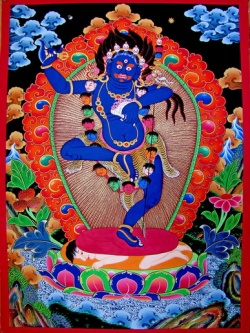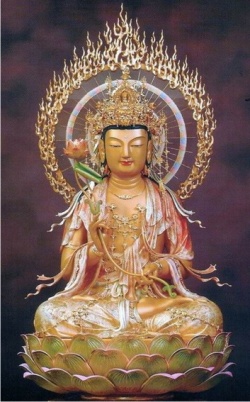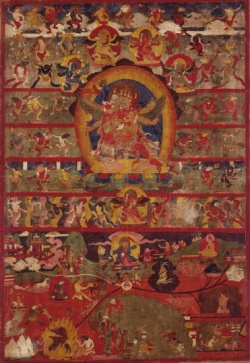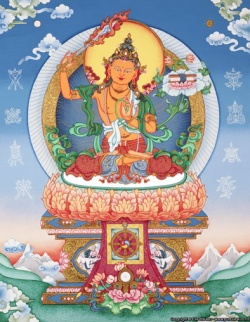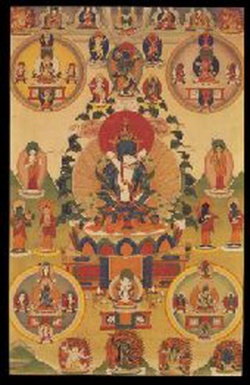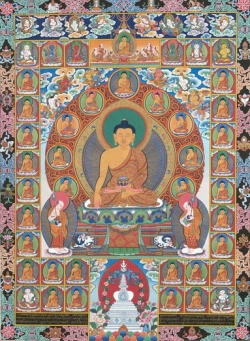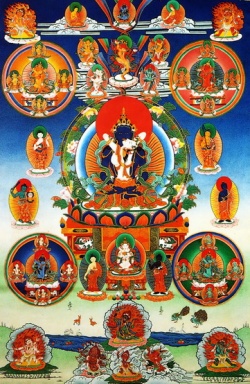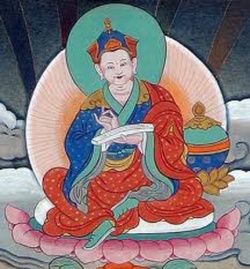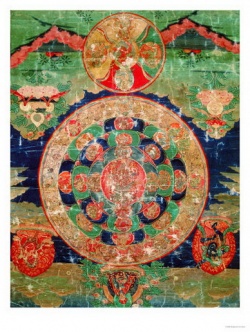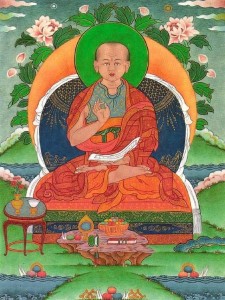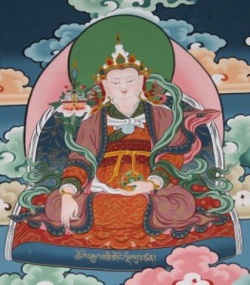Special days of the Tibetan Buddhist Calendar
by Ven. Lopon Osel
The Tibetan Buddhist calendar has special days throughout the year. This text is a commentary on the special times relating to Shakyamuni Buddha’s life, the ten Guru Rinpoche days, and the 25 dakini days, written by Tselea Natsog Rang Drol. Guru, Buddha, and Bodhisattvas, those having mastery of compassion, to them I pay homage and go for refuge.
With the intention to benefit those having faith, a correct attitude, and a mind of virtue, here I will explain the classification, enumeration and benefits of these special days. There are three topics: the general, the particular and their distinctions.
First, the general. In each month there are three special days in the lunar month calendar: the 8th day is called the day of Medicine Buddha. the full moon on the 15th day is the excellent day of Buddha Amitabha.the new moon on the 30th day is Buddha Shakyamuni Day.
It is taught that on these three excellent days, whatever kind of virtue that is done, great or small, is multiplied one hundred times in comparison to other days. For example, if one offers merely one butter lamp or a small torma, performs one prostration or one circumambulation, these offerings multiply by one hundred.
Also, one mala recitation of the six syllable mantra becomes the recitation of one hundred malas and creates the same merit. Ordinary lay-persons should keep the single day vows and the fasting practice on those days. Thereby, in all future lifetimes, for aeons one will be liberated from illness, warfare and famine and there will be great benefit. On these occasions, if one does defiled or non-virtuous acts, they also become multiplied by one hundred and this creates much negativity.
Then, in particular. The four great occasions of the Buddha’s life are: the time of enlightenment, the time of great miracles, the time of turning the wheel of dharma, and the time of descending from the god realm.
Firstly, the time of great miracles is during the new month of the Tibetan calendar following the New Year. At that time Buddha was forty years old, and there were six non-Buddhist Masters who had 84,000 disciples.
These disciples, because of jealousy toward Buddha and his followers, insisted on challenging Buddha to a competition of miracles. King Salgyal, a king who was friendly to the Dharma, and many of his guests at the competition said to the non-Buddhists, “You are just like a firefly’s light, but Buddha is like the sun and the moon.
You cannot compare to Buddha, so do not challenge the Buddha,” but the non-Buddhists did not take this advice. They persisted in challenging the Buddha and he agreed, but only because he saw how in the future the root of virtue would arise in many beings as a result.
In all the kingdoms of noble India, Kings and their people gathered in immeasurable numbers and on the following day Buddha gathered all types of beings, including gods, Nagas and smell eaters, local deities, various types of Yakshas from the hungry ghost and god realms, etc. All races of non-human beings gathered like massed banks of clouds.
In the day time of the first day at Shravasti, King Salgyal invited Buddha and all of his 80,000 disciples together with an equal number of the non-Buddhists, serving them both. Then Buddha put a toothpick on the ground and in a single moment, it became an immeasurably large wish-fulfilling tree.
Its leaves, flowers and fruit grew and ripened all at the same time, and a wind came and blew the tree, causing a great dharma sound to arise. The non-Buddhists were powerless and unable to accomplish a miracle in return.
Similarly, on the second day at the place of Yuldra Drok, a King named Utaya offered his service to the Buddha, and during this time precious jewels appeared to the left and right of Buddha’s body like giant mountains. Whoever saw these jewels, their minds were liberated and the state of Buddhahood was established. The non-Buddhists again achieved no miracles.
On the third day King Shunatsitha gave service, washing the Buddha’s feet with water. Some of this washing water flowed away and any beings that drank or touched this water achieved uncontaminated great blissfulness.
On the fourth day King Indrabhodi made offerings of incense water. Out of eight channels of fragrant water came the wonderful sounds of all the teachings of dharma so that whoever listened heard what they could never have imagined before.
On the fifth day was the time for King Tsangjin to make his offerings. From the opening of the mouth of the Buddha, golden-coloured light rays with immeasurable radiating lights pervaded all the realms, emptying the lower realms of beings, and there arose a great faith in beings.
On the sixth day at Vaishali, the Litsavi family made offerings. At that time the mind streams of all the disciples and all the surrounding people experienced the higher perception of knowing each other’s minds.
On the seventh day, in the city of Kapilavastu, the family of Shakya made offerings. At that time, Buddha manifested as a chakravartin king and all the beings there developed the noble mind of Bodhicitta.
During this time, the non-Buddhist masters were not able to demonstrate any miracles.
Then on the eighth day Indra, Lord of the gods, made offerings, and on the left and right side of Buddha’s body Brahma and Indra appeared in a state of great respect. then Buddha thought, ‘now is the time to tame the non-Buddhists,’ and by merely pressing down his right hand, suddenly, with a great roar like a dragon, five great, very wrathful Yakshas of frightening aspect appeared under the throne.
The five Yakshas then held the six non-Buddhist masters by their dreadlocks, and the wrathful Vajrapani placed his vajra fire blazing on their heads. Trying to escape, the non-Buddhists tried to fly miraculously to another country, but Vajrapani with his power made a great hurricane and they were unable to go.
So then the six masters and their non-Buddhist disciples jumped into the water and died. Some of the 60,000 of those that jumped, having been cleaned of their karmic fortune, took refuge in Buddha and then based on that became arhats.
Due to these causes and conditions, many Shravakas also attained the actual stage of Arhat. Then, from Buddha’s every pore, innumerable light rays and limitless emanations radiated out to the Buddha fields of the ten directions, bringing benefit to all beings, and the earth shook in six different ways, while gods sent down a shower of flowers. From then on, the non-Buddhists also did not find a way to compete.
Thus, in commemoration of Buddha’s complete victory in this competition with the non-Buddhists, from the first day up to the eighth day is known as Having Competition in Miracles.
The eighth day of miracles is also explained as the time when Buddha was born. Once, a generous householder asked Buddha, “ In what month and day were you born?” and Buddha replied, “on the eighth day of the last month of winter.” This date is given in one of the sutras.
From the ninth to the fifteenth day is known as Unrivalled in Miracles, although no actual rivalry existed. On the ninth day Brahma, the king of the gods, made his offering and Buddha’s body manifested as the size of Brahma’s realm, and the sound of dharma words miraculously pervaded everywhere in the god realm.
On the tenth day the four great kings made an offering and Buddha’s body appeared, the height of which touched to Akanishta, the palace’s of the four great kings, and the sound of dharma was made to pervade all the worlds.
On the eleventh day a generous householder made an offering. Then, in the center of his circle of attendants, while remaining in a human body, Buddha made the sound of dharma appear and all worlds were filled so that all gods and human beings became joyful.
On the twelfth day the householder Tsi Tras gave service and through the Buddha remaining in the meditative concentration of loving kindness, light rays from His body radiated out to the three billion worlds, filling everywhere, and by this light touching all beings made them full of loving kindness.
On the thirteenth day the King Shuntsidha worked again to offer service, and from the navel of the body of Buddha light radiated out continuously without interruption. From each of these light rays a form of the Buddha individually manifested, pervading space and displaying dharma teaching.
On the fourteenth day the King Utrayana, his Queen and all royalty paid homage by offering flowers, until there amassed cloudlike banks of flowers in space. On top of each flower were precious jewels, horses and carts with ornaments and decorations and different manifestations of Buddhas giving teachings.
On the fifteenth day the King ‘Essence of Form’, King Bimbis’ara made an offering and at that time all the retinue could see with the eyes of omniscience all beings remaining in all the places of the hells. By this they all became frightened and miserable and they cut their attachment to samsara, and attained certainty in the supreme mind of enlightenment.
In that way from the first day up to the fifteenth day, by showing these various miracles, each of them different, beings to be tamed were established in compassion. This is why these anniversaries of the miracles are great times of offering.
The First Stupa. Among the eight great stupas there is one known as the Miracle Stupa of ‘Many Doors’. This was built in Shravasti. Second is the actual stupa of enlightenment, the stupa of the great time of Enlightenment.
In the final month of spring, the third month of the lunar calendar, or the fourth Tibetan lunar month, on the fifteenth day, the full moon day, the Buddha turned thirty five years old. During one evening at Bodhgaya, by remaining in the meditative concentration of Bodhicitta, Buddha subdued great gatherings of many maras with his meditative concentration. Then, at noon, Buddha remained in the concentration of meditative equipoise; and at dawn Buddha manifested complete enlightenment by bestowing empowerments in the ten directions.
At that time there was an eclipse of the moon , the earth trembled and showers of flowers descended, and all the gods made offerings amassed like banks of clouds, from the palace of Serkye. Buddha’s son Rahula and attendant Ananda as well as other great Bhodisattvas were born during lunar eclipses. During the time of an eclipse the merit in making offerings to the Buddha is increased.
It was during eclipses that He was conceived in his Mother’s womb, when He turned the wheel of the Dharma, and when He finally entered parinirvana. These three important times are therefore very famous and great. Many great lamas teach this. At this time the great enlightenment stupa at Magadhar was also built.
Third. After Buddha did not teach for seven days, the gods Brahma and Indra requested Buddha to teach at Varanasi. This is when Buddha taught the Four Noble Truths, the first turning of the wheel. At that time the stupa of turning the wheel of the dharma was built. It has many doors and each one is decorated like temple doors at the city of Kashina.
As to the fourth day: Buddha’s mother, Gyutrulma, was re-incarnated, in the god realm known as the ‘Heaven of Thirty Three’. In order to repay her kindness, Buddha gave teachings of the dharma there where he spent the three months of the summer. He stayed and his mother and other beings achieved liberation.
In the second Tibetan month of autumn at the full moon day, all the gods made three different staircases come down from the god realm, made of jewels, gold and silver, and lapis lazuli. Buddha and his attendants, the gods Brahma and Indra, walked down the staircases together from the god realm to the city of Kashi, where an audience of Shravakas and many people gathered around. Some great teachers say this occurred on the full moon day and some say it occurred on the 22nd day.
This is because Buddha’s manifestation on these days is in accordance with the different wishes in the minds of people. to remember this event, a stupa with many steps around the centre was built at that place in the city of Kashi..
Accordingly, at these four great times of Buddha’s life, any virtue and any negative deeds that are done become multiplied by one million, so deeds become very strong. Both the sutras and the shastras teach this.
As an example to make it easy to understand, during these times if one gives a single grain to a beggar with pure intention, then that becomes, in virtue, as if one had given one million grains. Thus, any object that one gives also becomes more powerful and the merit becomes greater.
Also, the recipient of generosity influences the merit gained: compared to the virtue of giving to an ordinary person the merit of giving to a Brahmin is ten thousand times greater. The merit increases more when giving to a sick person rather than to a medical doctor, more to someone who is writing many dharma texts or to an artist making dharma statues and pictures than to give to a monk who has lax morality,
and even more to an Arhat rather than a monk who observes his vows. It is especially good to give to Mantrayana practitioners, and even better to give to a Vajra master at the accomplishment stage, when the merit multiplies by one hundred thousand.
As to the others. During a solar eclipse, the merit of virtuous or negative acts are said to multiply by ten thousand. For example, if one offers a butter lamp, water offering or torma, the virtue of one single offering increases ten thousand times. Just one recitation of the six syllable mantra also becomes ten thousand recitations. The aspiration prayer of Samantabhadra, the Heart Sutra, etc.,
practiced only once on this day also becomes ten thousand. Negative acts, too, multiply by ten thousand. For example, killing one being would have the same negative karma as killing ten thousand on an ordinary day. During a lunar eclipse, each single virtuous or negative act is multiplied by one thousand.
From the oral transmission teachings, it is said that when either solar and lunar eclipses coincide with one of Buddha’s special days, the effect greatly increases many times. During a solar eclipse whatever is done is increased by a hundred thousand million and at the time of the moon eclipse by seven million.
The fourth great time together with an eclipse increases merit more than the others. Thus Buddha taught.
Basically the full moon day, the last day of the month, and the eighth day are all special times to make offerings to the Buddha or for doing practices. In particular, during sun and moon eclipses, one should offer with one’s body and resources, and roots of virtue will be accomplished excellently.
If one does not have that practice, then at least one should not do negative things on that day. This is a very important teaching found throughout the Buddha’s sutras and shastras, and all the vast and profound teachings say this without contradiction.
At such excellent times one should undertake virtue and abandon negative deeds, adopt this without any mistaken understanding as to the result, just as the Buddha taught. Do not show disrespect to the Triple Gems or your father and mother, and do not disparage dharma siblings.
Do not fail to bestow service to parents or sick people, do not eat offerings of the faithful and do not fail to engage in virtue, do not break the continuity of practice and do not fail to give to the poor. Do not fail to give if you have wealth.
If you purify these defilements then that will become the cause of holy enlightenment. This is the teaching for ordinary people. For ordained persons in particular it necessary to avoid the following.
Taking a person as the object of desire and being attached to worldly relatives, befriending people with negative behavior and impure natures, holding the eight bad livelihoods, or being attached to women or the taste of meat or alcohol; enjoying distraction and agitation, and engaging in gossip, etc.
At the time of the four offerings, non-ordained practitioners should also keep these commitments. Then the conditions of ease and the prerequisites for a precious human rebirth, entering the dharma from birth, and then by stages developing the capacity for enlightenment are established.
However, by breaking the following commitments one will be thrown directly to the hell realms. If one makes a virtuous connection with the Guru and then breaks samaya; if one who has made the Bodhicitta vow offers service only in order to attain riches; practicing a false form of dharma; engaging, through self or others,
in negative acts, using for oneself the resources offered to any of the four fully ordained monks; deceiving good friends or breaking any of the seven Vinaya vows; abandoning the Triple Gems or the guru; doing any of the five heinous deeds; causing division among the Sangha: all of these result in going directly to the hell realms like a stone shot from a catapult.
Even for such people who have behaved in this way, if they maintain their commitments at those four excellent times they will become without fault. As karma and result are never deceiving like having a very big rock on one’s head, momentarily experiencing suffering then at these special times acting virtuosly, those negative karmas will be very quickly finished and the seed of enlightenment will be sown. this is the teaching.
The eight impure livelihoods, mentioned above, are: 1. a worldly householder 2. an owner of fields 3. a maker of weapons 4. a trader or one who lends for profit 5. the owner of horses and pack animals 6. A herder and milker 7. A producer of meat, and 8. a producer of alcohol. In these eight a fully ordained monk or nun must not engage.
In that way the sutra of the ChiDo Kongdu tradition has explained about the auspicious times and the actual benefits they hold, and in particular, the practices in the inner secret mantrayana of wrathful practice, etc. At this time, explaining these practices will not be done here. For those who have the wish to do these practices, at this time body washing for wrathful practice arises, but nowadays this is very rare.
Here, practiced only in the unsurpassable mantrayanas (the maha, anu and ati yogas)are the two auspicious days: the tenth day of the waxing moon (Guru Padmasambava’s day) and the 25th day of the waning moon (Dakini day).
On both these auspicious days, all the dakas and dakinis gather, so we should engage in making ceremonial tsok offerings to the mandala on that day. As a result there will be immeasurable blessings and great merit. Also, there are the inner practices of the holy places in the places of our vajra body, the white and red elements, the method and wisdom, the great gathering into the mandala, etc.
If at these two stages of the moon we do this yoga diligently, we will perform the mantrayana inner tantra section as explained without contradiction.
Furthermore, by the methods of the secret Vajrayana tradition, such as making offerings on the tenth day of the waxing moon the benefit and merit are inconceivable. In one year there are twelve months, each with a tenth day that celebrate special events in Guru Rinpoche’s life.
On the tenth day of the twelfth month, King Indrabochi invited Guru Rinpoche to his palace, gave him the name Pema Gyalpo and Guru Rinpoche became the son of the King.
On the tenth day of the first month, renouncing the activities of a king’s son, Guru Rinpoche performed yogic practices at the great charnel ground of Sitavana, the eastern one of the eight charnel grounds of India and is known as Guru Shantarakshita.
On the tenth day of the second Tibetan month, at Zahor, a country of north western India, Master Trabhahati (Ananda) ordained Guru Rinpoche, so it was on that special day that he became known as Guru Shakya Senge.
On the tenth day of the third Tibetan month, the king of Zahor tried to burn Guru Rinpoche alive. He did not burn; instead, he transformed the fire into the lake Tsopema at Rewalsar.
On the tenth day of the fourth Tibetan month the ministers of Orgyen try to burn Guru Rinpoche and Mandarava, his spiritual consort. The King put them into fire for seven days but they did not burn.
On the tenth day of the fifth Tibetan month, at the South Indian Nalanda University, learned
non-Buddhists came to debate the Buddhists. Many months of debating took place and the Buddhist scholars could not defeat the Tirthikas. Then one day a dakini came in the night to a Buddhist scholar with this prediction: you cannot defeat them, you must invite my uncle Pema Jugne and he will win. As he was living in a cemetery, they had thought it was too far for them to go, but the dakini instructed them to make offerings and do the seven line prayer, which the dakini gave to them, so Guru Rinpoche would instantly come.
So they did this and Guru Rinpoche instantly came. Guru Rinpoche debated with overwhelming superiority, performed miracles, brought victory to the Buddhists, and all were converted to Buddhism. Because the non-Buddhist people were all converted at this time, it is a very special important offering day.
On the tenth day of the sixth Tibetan month, Guru Rinpoche was born on a lotus bed on Lake Dhanakosha. This time of the miraculous birth is the main auspicious day.
On the tenth day of waxing moon of the seventh Tibetan month, in the barbaric country Zang Ling (Tamradvipa), a non-Buddhist King trapped Guru Rinpoche in a container and put him into the water of the river Ganges. Guru Rinpoche flew into the sky and reversed the flow of the river towards its source and the non-Buddhist King’s palace flooded and was almost destroyed. The non-Buddhist King then regretted
His action and took refuge, then he and all his followers came into the Buddhist doctrine.
On the tenth waxing moon day of the eighth Tibetan month, a non-Buddhist tried to poison Guru Rinpoche, offering poisons of all different kinds: some that if you touch them you become sick, some if you eat them you become sick and some that if you see them you become sick. They were all wishing to kill Guru Rinpoche. However, whatever they gave him had no effect and no harm was done to him. Rather, he even became stronger, more powerful and more manifest.
On the tenth day of the waxing moon of the ninth month, at Parphing in Nepal, the local deities were making obstacles for Guru Rinpoche. For three years there was no rain, and because of this he realized that they were making obstacles. He did Vajrakilaya (Palchen Yangdak) practice and accomplished realization, so all the local deities were subdued and they became protectors of the dharma.
On the tenth day of the tenth month, Guru Rinpoche came to Tibet. There were many maras and demonic obstacles and at that time he began to subdue the Tibetans. He subdued the local protector Chu Nyi and founded Samye Monastery and Chimbur.
On the tenth day of the eleventh month, all the panditas met with Guru Rinpoche and put Terma (Dharma treasures) in many places. They put Terma, jewels and Dharma objects all over Tibet, Nepal and Bhutan–about a million Terma were hidden beginning at this time at various places. All the obstacle-making maras and demons were all gathered, and for each one of them, a Terma was placed to subdue them and protect the Dharma.
When the correctly named Terton comes and the correct person requests that Terma, it is revealed. All of that was put in place at that time.
According to two differents commentaries, Guru Rinpoche’s birthday occurs in two different months. For both these tenth days there are three excellent times during the day. It was both when Guru Rinpoche was born and when he went to the copper-colored mountain in the south land. He himself declared this.
The tenth day of every month is very important, but the tenth day of the sixth month of the monkey year is the most important and the most powerful. Whoever does Guru Rinpoche practice or any deity and offers tsok on that day, the actual Guru Rinpoche will appear before them. This commitment he made for every tenth day; however, this day is the most powerful for disciples with good faith and devotion and aspiration.
This is declared in the Buddha’s teachings which cannot deceive. For this reason, it is very important at this time to hold an offering and a tsok: offer, supplicate, and engage in virtue diligently.
During those two tenth days, offerings are of great benefit. This is also stated in the immeasurable terma of these teachings. Shubu Choedrak is one terton, and in that particular terma, he explains the tenth day offerings and their benefit for all the tenth days of all of the twelve months. It explains individually how they benefit with many detailed explanations.
Part of the essence meaning of these teachings is that even though we may not be able to see due to our great defilements, Guru Rinpoche directly appears and gives blessings. He made that promise from his own mouth that he would bless in this way, so it is not needed to have more explanations. Even so, there are further explanations in many sutras and tantras.
Colophon:
If each special day of each month with the meaning and what is necessary were explained here as was requested, that would take too long to be completed. Then again, some people strongly requested this teaching from me, the old man Natsog Rang Drol, who cannot see very well with his eyes, but I wish to give benefit to other beings, so I wrote this. Mangalam.
A short history of Tsele Natsog Rang Drol- A great teacher with accomplishment, he was a student of Khyentse Wangpo and he requested from his teacher many Terma (a choedak). He was a great Dzogchen practitioner who wrote many wonderful sutras, tantras, commentaries and the uncommon Dzogchen commentary.
He wrote very important texts. If you want to know more, there are seven very important volumes of his texts. He is a great non-sectarian master of the rimé tradition. He also wrote a Mahamudra commentary. If you are interested in his history then look at some translated books of his on Bardo, Mahamudra and Dzogchen,
Translators Colophon:
This text was translated directly from the Tibetan commentary to English on the 25th of August, 2007 at Salt Lake City, USA by Lopon Osel Gyurme helping to explain the Tibetan text and Kunga Sonam Dronma writing in English.
We both wish that people know more about the story of Buddha and Guru Rinpoche so they can become true believers and gain confidence in Dharma. We also would like to dedicate this effort to all beings so they can become aware of the importance and meaning of special days, and gain the ability to practice with true devotion as a result. May all beings see the true qualities and activities of Shakyamuni Buddha and Guru Rinpoche. It is a wonderful and supreme history that we have translated here. With this virtue, may all samsara become nirvana. Sarwa Mangalam!
